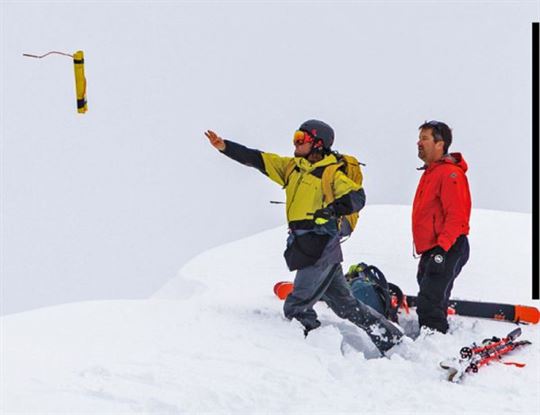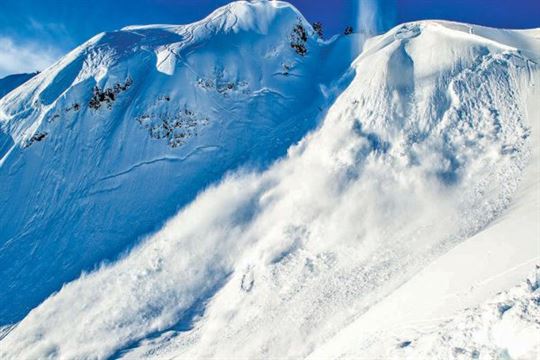The chance of dying in an avalanche is probably a lot less than you think.
by GEORGE KOCH * photos by GRANT GUNDERSON * in December 2017 issue
Can you put a number to your chances of surviving your next backcountry skiing adventure? Should mountain guides deliver mathematical certainty in their risk assessments and terrain selection? In our hyper-digitized age, when computer models are treated with quasi-religious reverence and many technocrats endorse the fallacy, “If you can’t measure it, then it doesn’t exist,” it’s tempting to believe that snow science has ascended to mathematical precision and avalanche risk management should be driven by exact numbers. But is this reasonable?
‘‘…it’s tempting to believe that snow science has ascended to mathematical precision and avalanche risk management should be driven by exact numbers. ’’
These questions arose following a serious avalanche incident that befell a tight-knit group of friends from Ontario at one of B.C.’s snowcat-skiing destinations last season. None of the 12 was killed, thankfully, but six were swept away by what was later described as a “large Class II” avalanche. Two of the six struck trees or rocks, one suffering a twisted knee and the other a concussion plus cracked ribs.
Following this stark reminder of human frailty, David, who had triggered the slide and gone for a long ride but walked away from it (he was wearing an ABS pack), began reading up on avalanche risks. In Staying Alive in Avalanche Terrain (2nd edition, 2008), the seminal book by American expert Bruce Tremper, David came across a frightening actuarial table. In it Tremper depicts how quickly backcountry skiers can expect to generate their own catastrophes. Assuming an enthusiast headed out 100 times over the season and crossed 10 avalanche slopes each day, with 95 per cent of those slopes being (coincidentally) stable, that skier should expect to accidentally trigger 50 avalanches, be caught in about 17 slides and be killed no fewer than five times over.
David was seriously spooked. Ninety-five per cent stability sounds high. Yet if that’s all a guided backcountry operation provided, the typical guest could expect to perish after just 20 skiing days. Which is bonkers. Yet according to Tremper’s table, even someone making correct decisions 99 per cent of the time would likely die in their first season. To achieve even marginally acceptable longevity of 10 years demands 99.9 per cent correct decision-making. And even if that’s okay for you, a 10-year life expectancy is hardly saleable to your loving spouse, offspring, siblings or parents. Going by Tremper’s assumptions, for backcountry skiing to be regarded as safe would require correct decisions 99.99 per cent of the time. Can any lodge operator or mountain guide achieve that?
Luckily David’s friend Neil, a 45-year-old finance expert with an MBA whose real estate development work sees him constantly dealing with columns of numbers, dove into the conversation. An avid heli- and snowcat-skier, Neil pointed out that, first of all, Tremper’s table is labelled “Fictional”; all its parameters are assumed. It also omits avalanche size—surely relevant in determining how “often” someone would be killed. Tremper’s write-up discusses four main factors, but the table only has three columns of variables. In Neil’s mind, a serious actuarial mistake. And Tremper’s assumed ratio of fatalities to triggered avalanches is much higher than depicted in a graph of actual avalanche accidents on the book’s next page.
“If you’re going backcountry skiing with math as your guide, you can make the sport look incredibly dangerous or safe by altering one or two assumptions,” notes Neil. “If people with no training are unknowingly exposing themselves to a five per cent risk factor, those people are playing with fire. But if the commercial operators were really operating in Tremper’s 95 per cent probability, and his underlying assumptions were also correct, they’d be reporting 15 fatalities every season for every snowcat they operate. Clearly that can’t be what experienced backcountry travellers and guided groups are doing.” And, in fact, cat-skiing deaths from all causes have been extremely rare over the sport’s more than 40-year history, with most putting the total number at fewer than 12.
Given its artificiality, perhaps Tremper’s table was mainly intended to underscore the life-and-death importance of avalanche knowledge, training, equipment and procedures by illustrating what could happen to clueless backcountry travellers with zero avalanche skills. What looked to David like a predictor of his and his friends’ potential demise was, by Neil’s reading, merely a reinforcement of the need for measures that move one up the decision ratio. Either Tremper’s basic assumptions are wildly pessimistic or the combination of formal risk management by commercial operators, expert mountain guiding, avalanche safety equipment and training of guests is indeed raising the percentage of correct decisions into the 99.9-99.99 per cent range.
‘‘…the critical specifics that cause a particular slope with a particular depth and structure of snow to release at a particular instant can never be calculated”
Rather than pondering and arguing over numbers like these, however, we ought to discard them entirely. Even to place a numerical probability on a given slope letting loose or on the certainty of a backcountry traveller’s decisions is to misunderstand the nature of avalanche forecasting. Although the mechanisms that cause avalanches are conceptually well-understood and can be expressed as mathematical formulae, the critical specifics that cause a particular slope with a particular depth and structure of snow to release at a particular instant can never be calculated. And it’s this one fact that determines the nature of avalanche forecasting.
Because avalanche triggering remains intrinsically uncertain, the forecasting process is built around human minds gathering often voluminous but always incomplete information and using inductive thinking and time-tested principles to arrive at reasonable conclusions. These conclusions shape avalanche forecasts and guiding decisions,
all of which are built around non-mathematical probabilities. Frequently used words such as “likely,” “widespread” and “large” are clues to this. The widespread use of numbers within the process—temperatures, wind speeds, snowfalls, grain sizes, slope angles and many others—possibly obscures the forecast’s non-mathematical nature. While there’s a great deal of data gathering, the data are not plugged into a computer that can spit out a precise and certain prediction.
Because forecasts and decisions involve irreducible uncertainty, they also carry residual risk. Neither the probability of the assessment, its confidence level, nor the residual risk can be quantified. Indeed, the Canadian Avalanche Association’s recently published TASARM document emphasizes that “irreducible uncertainty” is “an inherent part of snow avalanche risk management” and that accommodating uncertainty begins with “acknowledging its existence.”

“My ski trip every year is pure nirvana, and I can’t wait to get to the mountains—they’re my happy place,” says Neil. “My whole purpose in choosing guided skiing is to ski with professionals who have the training to take me where I’ll have a shit-assed grin all day long, but without having to worry the whole time whether I’ll trigger an avalanche, and where I can sit in the hot tub at the end of the day with a beer talking about what a great day I’ve had. But while other people want blacks-and-whites, zeroes and ones, I get that avalanche forecasting, though making use of science, is not mathematically precise, that it’s a process of managed risk rather than risk elimination.”
How do professionals cope with the demand for ever-better risk management and higher safety within a field that can’t deliver numbers or certainty? Doug Latimer, a long-time mountain guide who teaches avalanche safety and backcountry touring courses, says he struggled for years over how to give proper weight to residual risk. Finally he settled on a simple, stark mechanism: Would he allow his own son to travel on the avalanche terrain in question? Says Latimer: “If the answer is ‘No’, then I would not let anyone else do so.” Although Latimer cautions that this is “not a formulated process and does bring in elements of heuristics and human error,” applying the “My Own Son” principle helps him crystallize whether he has done everything he can to understand the situation and correctly handle the risk.
Despite the near-miss experienced by David, Neil and their friends last season, there’s another bit of very good news: avalanche deaths are no longer zooming as they did in the early 2000s and, previously, the ’70s and ’80s. In Switzerland, fatalities fluctuate year-to-year but were essentially flat at 25 per year over the past decade. In the U.S., the five-year moving average is about 30 per season. In Canada, more deadly accidents among snowmobilers in recent years have been offset by fewer backcountry skiers and snowboarders dying, and we are averaging about 14 avalanche deaths per year from all causes nationwide. This despite the explosion of self-guided ski touring and past-the-ski-area-ropes travel. Avalanche risk management, while imperfect, is indeed working.




